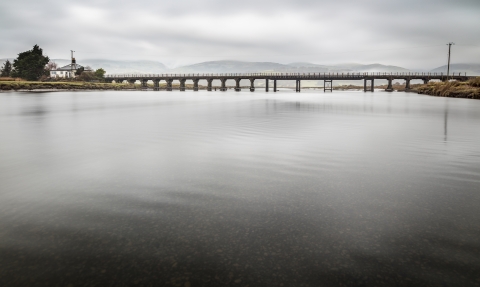
Bridge
The Stories Beneath...
Uncover the stories hidden within the Dyfi Wildlife Centre building
|
Many stories are told through the materials that have been used to build and furnish the Dyfi Wildlife Centre. From a staircase shaped like a ship to a chair carved with beavers we hope you enjoy learning more about the history of the Dyfi River and its people. Sustainability has always been at the centre of this project and we have worked hard to embody the principles of 'Reduce - Reuse - Recycle'. Many items have been recycled and repurposed as features in the Centre. The links below explain a little more about the key features in the building. |
The 'Mary Evans' Staircase
At the heart of the building is a Welsh oak staircase which has been hand crafted to look like the frame of a ship. It is based on the 'Mary Evans', the largest boat ever built on the Dyfi River. Built in 1867 by John Evans at his ship yard at Morben, right next door to the Dyfi Wildlife Centre. The 'Mary Evans' carried cargoes of timber and oak bark around the world.
A Clean Slate
From the reclaimed slates on the centre's roof to those covering the wall opposite the centre reception desk and shop. Slate is as integral to the Dyfi Wildlife Centre as it is to the history of the valley. Slate was transported down river from Derwenlas to Aberdyfi from where it was exported around the world.
The Cwtch Brethyn
A 'cwtch' in Welsh can simply mean a 'cuddle' or a 'snuggle', but it is also much more than those things, it is a sense of warm cosiness, contentment and wellbeing. It is a bit like the Danish and Norwegian concept of 'hygge'. So, what could be more cosy than a Welsh woollen blanket? Especially one woven in the Dyfi Valley. Our 'cwtch' is filled with locally woven 'brethyn' or tweed.
Tŷ Maenan
Our cafe is called Caffi Tŷ Maenan, it is named after the ruins of a house on a small rocky outcrop, on the salt marsh, not far from the osprey nest. 'Tŷ' is the Welsh word for house and 'Maen' means rock or stone so the name translates as the rock house or house on the rock. In the 1850s the house was used as a 'tafarn' or pub by the sailors waiting for the next high tide to take their boats to Derwenlas.
The Beaver Chair
Made from reclaimed wood our unique beaver chair has been designed to highlight the connection between animals and their habitats. The beaver enclosure on Cors Dyfi is a great step forward in reintroducing this ecosystem engineer to a whole river system. Maybe we could one day make a chair out of beaver chewed wood?!
Building on a Bog
The Dyfi Wildlife Centre does not actually touch the bog, it is 'floating' a little way above it on a series of pilings connected by a steel subframe. There are 33 pilings under the building, each going down around 16m into the ground below.
Local Timber
The Dyfi Wildlife Centre is clad in timber that was grown, felled and processed right here in the Dyfi Valley.
Lighting the Way
The feature lighting in the Dyfi Wildlife Centre have been chosen to reflect the both the maritime and the mining history of the area. Our copper pendent lights have been reclaimed from ships that once sailed the worlds oceans.